-
![Poly(Diallyl Dimethyl Ammonium Chloride) [Mw ~ 8,500], 28 wt. % H2O](https://www.polysciences.com/media/catalog/product/cache/41caa8e834a03fb3ab31ba2c24269124/2/4/24828_1.png) Poly(Diallyl Dimethyl Ammonium Chloride) [Mw ~ 8,500], 28 wt. % H2OCatalog Number 24828
Poly(Diallyl Dimethyl Ammonium Chloride) [Mw ~ 8,500], 28 wt. % H2OCatalog Number 24828Water soluble cationic polymer. High cationic charge density in ready to use aqueous solution form. Material is quaternized cyclic amine supplied as the quarternary amine chloride.
The ability to modify surfaces and provide cationic character allows the user to selectively attract negatively charged functional groups to the coated surface or to the dissolved water soluble cationic polymers.
This feature is useful in the following types of applications:
- heavy metal removal by chelation
- promotion of precipitation or flocculation of dissolved solids
- imparting antistatic properties
- adding anti-microbial character
- binding of dyes or inks
- anionic pigment binding
- decolorizing agent
- binding to aldehydes
- corrosion inhibition on metal surfaces
- polymer bridging to link functionalized polymer systems 28% Solids in water Available in several molecular weight ranges. If other molecular weights are required, please call us for a custom quotation.
-
![Poly(l-lysine hydrobromide) [MW 275,000]](https://www.polysciences.com/media/catalog/product/cache/41caa8e834a03fb3ab31ba2c24269124/2/5/25724.jpg) Poly(l-lysine hydrobromide) [MW 275,000]Catalog Number 25724Inquire for availability.Phone: +(49) 6201-845200Email: [email protected]
Poly(l-lysine hydrobromide) [MW 275,000]Catalog Number 25724Inquire for availability.Phone: +(49) 6201-845200Email: [email protected]Cationic polymer. Used for promotion of cell adhesion to solid surfaces.
-
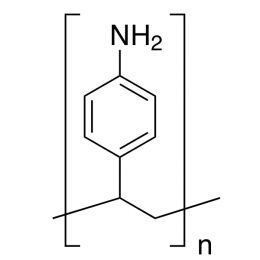 Poly(4-aminostyrene)Catalog Number 02823
Poly(4-aminostyrene)Catalog Number 02823Polymeric aromatic primary amine. Prone to oxidative crosslinking.
- Insoluble in organic solvents
- Nitrogen content ~11%
-
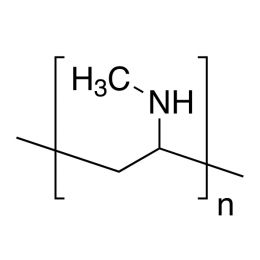 Poly(N-methylvinylamine)Catalog Number 24038Inquire for availability.Phone: +(49) 6201-845200Email: [email protected]
Poly(N-methylvinylamine)Catalog Number 24038Inquire for availability.Phone: +(49) 6201-845200Email: [email protected]Water-soluble all-secondary polyamine.
-
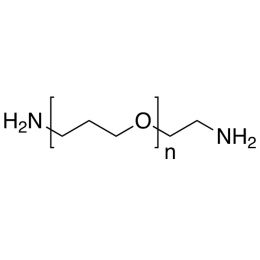 Poly(ethylene glycol) bis (2-aminoethyl), MW 10,000Catalog Number 24303
Poly(ethylene glycol) bis (2-aminoethyl), MW 10,000Catalog Number 24303A bifunctional Poly(ethylene glycol) derivative that can be used to conjugate proteins and drug substances for targeted drug delivery studies. Shelf life: stable when stored at room temperature
Synonym: Poly(oxy-1,2-ethanediyl) α 2-aminoethyl ω 2-aminoethoxy
-
![Poly(diallyldimethylammonium chloride) [MW ~ 240,000], Powder](https://www.polysciences.com/media/catalog/product/cache/41caa8e834a03fb3ab31ba2c24269124/1/7/17338_1.png) Poly(diallyldimethylammonium chloride) [MW ~ 240,000], PowderCatalog Number 17338
Poly(diallyldimethylammonium chloride) [MW ~ 240,000], PowderCatalog Number 17338Linear, cationic, aliphatic, quaternary ammonium cyclopolymer.
-
![Poly(diallyldimethylammonium chloride) [MW ~ 240,000], 28 wt. % in H2O](https://www.polysciences.com/media/catalog/product/cache/41caa8e834a03fb3ab31ba2c24269124/1/9/19898_1.png) Poly(diallyldimethylammonium chloride) [MW ~ 240,000], 28 wt. % in H2OCatalog Number 19898
Poly(diallyldimethylammonium chloride) [MW ~ 240,000], 28 wt. % in H2OCatalog Number 19898Linear, cationic, aliphatic, quaternary ammonium cyclopolymer.
28% soln. in water (70g polymer)
-
 Poly(2-vinyl-1-methylpyridinium bromide), 20% soln. in waterCatalog Number 21477
Poly(2-vinyl-1-methylpyridinium bromide), 20% soln. in waterCatalog Number 21477Cationic quaternary ammonium polymer.
20% soln. in water (2g polymer) Degree of quaternization 50%
-
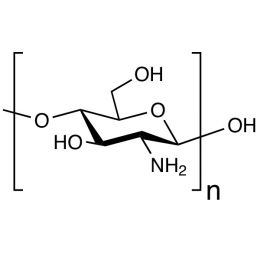 Chitosan, Purified Powder MW ~15,000Catalog Number 21161
Chitosan, Purified Powder MW ~15,000Catalog Number 21161Cationic polymer prepared by deacetylation of chitin. Soluble in water at low (4-6) pH.
poly[d-glucosamine] Purified powder Degree of deacetylation: minimum 85%
-
![Poly(l-lysine hydrobromide) [MW 50,000]](https://www.polysciences.com/media/catalog/product/cache/41caa8e834a03fb3ab31ba2c24269124/1/8/18619.jpg) Poly(l-lysine hydrobromide) [MW 50,000]Catalog Number 18619
Poly(l-lysine hydrobromide) [MW 50,000]Catalog Number 18619Cationic polymer. Used for promotion of cell adhesion to glass surfaces.
-
![Poly(l-lysine hydrobromide) [MW 120,000]](https://www.polysciences.com/media/catalog/product/cache/41caa8e834a03fb3ab31ba2c24269124/2/1/21430.jpg) Poly(l-lysine hydrobromide) [MW 120,000]Catalog Number 21430
Poly(l-lysine hydrobromide) [MW 120,000]Catalog Number 21430Cationic polymer. Used for promotion of cell adhesion to solid surfaces.
-
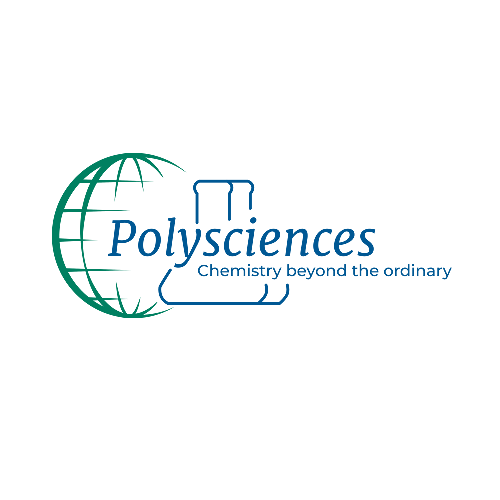 Poly(vinylamine) hydrochlorideCatalog Number 23965
Poly(vinylamine) hydrochlorideCatalog Number 23965Water-soluble all-primary polyamine.
-
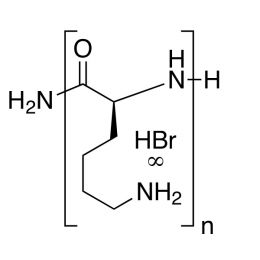 Poly(L-lysine hydrobromide), MW 125K, 0.1% aq. soln.Catalog Number 09730
Poly(L-lysine hydrobromide), MW 125K, 0.1% aq. soln.Catalog Number 09730Cationic polymer. Used to improve cell adhesion to solid surfaces.
0.1% soln. in water
-
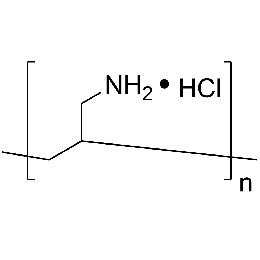 Poly(allylamine hydrochloride), MW 150000, 40% aq. soln.Catalog Number 25673
Poly(allylamine hydrochloride), MW 150000, 40% aq. soln.Catalog Number 25673Polymeric primary amine. 40% AQ solution.
-
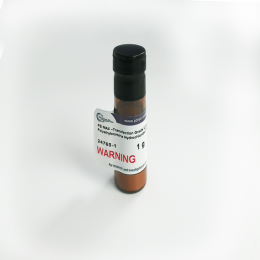 PEI MAX® - Transfection Grade Linear Polyethylenimine Hydrochloride (MW 40,000)Catalog Number 24765Email: [email protected]
PEI MAX® - Transfection Grade Linear Polyethylenimine Hydrochloride (MW 40,000)Catalog Number 24765Email: [email protected]Polyethylenimine “Max” (PEI MAX) is a highly efficient transfection reagent which is compatible for a wide range of cell lines/types including the most commonly used HEK293 and CHO cells grown in adherent and suspension cultures.
-
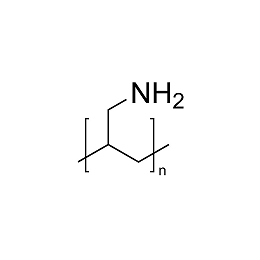 Poly(allylamine), MW 15000, 15% aq. soln.Catalog Number 24826
Poly(allylamine), MW 15000, 15% aq. soln.Catalog Number 24826Water soluble cationic polymer with primary amino groups (free base types) for chemical reactions. High cationic charge density in ready to use aqueous solution form. The structure of these materials is a repeating polymer of the allyl amine group shown at right.
Ability to modify surfaces and provide cationic character allows the user to selectively attract negatively charged functional groups to the coated surface or to the dissolved water soluble cationic polymers.
Amine Functional Polymers
